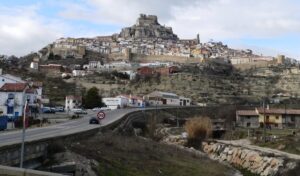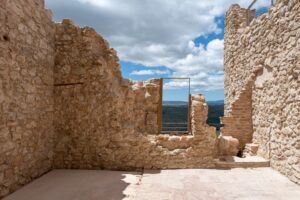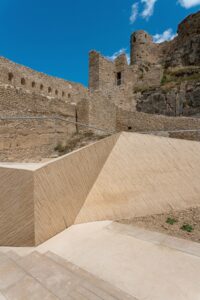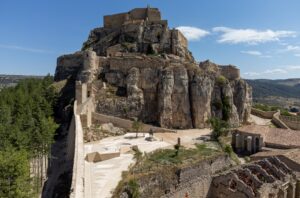The Castle of Morella is in the ancient walled city of Morella, located on a hilltop in the province of Castellón, Valencian Community, Spain.
 There are traces of settlement by the Iberians, succeeded by the Greeks and Romans, Visigoths and the Moors.
There are traces of settlement by the Iberians, succeeded by the Greeks and Romans, Visigoths and the Moors.
From the early 17th century to the Spanish Civil War, the town was often fought over, due to its strategic situation between the Ebro and the coastal plain of Valencia.
El Cid is reputed to have rebuilt the castle, which dominates the town, sometime prior to 1084.
Now, the castle has been restored by the architects of Carquero Arquitectura.
Here’s what the architects say about the restoration project:
 The general criteria for the intervention was to restore and consolidate the existing masonry, maintaining their ruinous physiognomy, mainly in their crowns, hollows, and surfaces, avoiding reinterpretation of the original state
The general criteria for the intervention was to restore and consolidate the existing masonry, maintaining their ruinous physiognomy, mainly in their crowns, hollows, and surfaces, avoiding reinterpretation of the original state
For the necessary added structural elements, have been used compatible materials such as lime concrete, stainless steel, and glass fiber reinforcing, with tones and textures that integrate with the rest of the interesting historical stratigraphy of the existing and discovered masonry.
In the same way, for the necessary added functional elements such as carpentry, it has been used stainless steel with titanium steam treatment, giving it a finish that integrates with the rest of the intervention.
 In the area of the loopholed wall, about 70 meters long and about 14 meters high, the main work has been focused on structural consolidation, being at risk of collapse, as well as the cleaning and restoration.
In the area of the loopholed wall, about 70 meters long and about 14 meters high, the main work has been focused on structural consolidation, being at risk of collapse, as well as the cleaning and restoration.
Outside the walls, four buttresses have been placed, reinforcing the foundation, recovering the exported land, and sealing and consolidating cracks.
In the interior of the walls, an important volume from Carlist War period fillings has been removed because they affected structurally the wall, appearing numerous archaeological remains, deposited in the Museum of the Castle of Morella, as well as the finding of three lime ovens, leaving visible medieval rammed-earth that remained hidden.
For the collection of rainwater, the main cause of the pathologies caused in the masonry of the Castle, a system of diffuse pavements and pipes have been arranged that direct the waters to a pre-existing outdoor pool.
 The access to the Sant Francesc Tower has been recovered by the execution of the roof in its wall-walks annex, its stairs, and the increase of the semi-demolished wall and the tense.
The access to the Sant Francesc Tower has been recovered by the execution of the roof in its wall-walks annex, its stairs, and the increase of the semi-demolished wall and the tense.
All the masonry has been restored, including the ramp and its annex building.
In the area of Pardala Tower, the entire filling has been emptied to its original level to be able to waterproof and systematize the collection of water, executing his lost cover.
The exterior masonry has been restored, with curious finds such as cannonballs embedded in the Tower, or a hidden gunboat.
All photographs are by Joan Roig, except the featured panoramic photo, which is by Kriegerkalle via Wikipedia.

